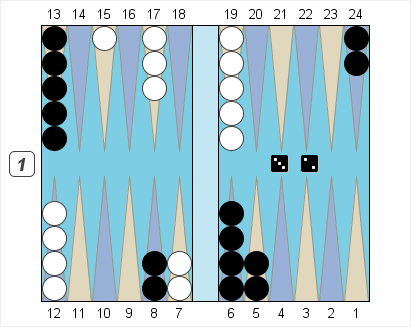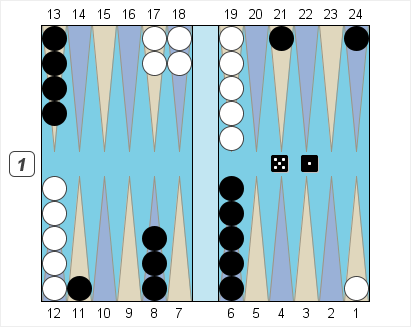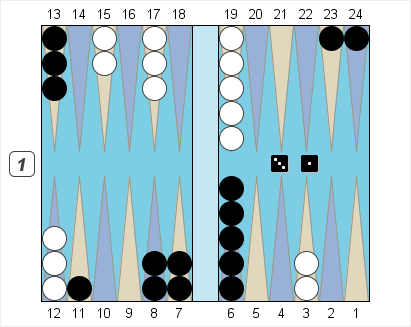The backgammon boom continues apace, with new tournaments popping up on the calendar on a regular basis. Two new tournaments appeared in just the past month: the Boston Open (Feb. 23-26) and the Viking Classic in Bloomington, MN (Mar. 9-12). Both were well attended, with 82 players in Boston and 83 players in Minnesota, very strong numbers for first-time events.
To help kick off the Boston tournament, I created a quiz contest for Sunday morning, with no entry fee and a $100 prize to the winner. Marty Storer of New Hampshire took first place with an outstanding score of 17/20, closely followed by Dennis Culpepper of Virginia with 16/20.
The collection of problems in the quiz is a little unusual. There aren’t any weird, tricky positions or difficult cube decisions based on match score considerations. It’s just a group of pretty normal positions where the choice is between two or three reasonable-looking plays. The idea here is to understand where you want to put your checkers when there’s nothing decisive to do this turn.
This blog post contains the first five problems of the quiz. Over the next couple of weeks, I’ll post the remaining 15 problems, five at a time. Enjoy!
Problem 1: Black to play 4-3

Black – Pips 167
Black to Play 4-3
As a general rule, when our opponent splits on the opening roll, we want to split as well. But 24/21 13/9 leaves White a direct shot, so most players settle on 24/20 13/10 as their play.
But this move has a problem as well. When your opponent splits with a deuce, you shouldn’t be eager to leave a blot on your 10-point. If you do, White has 10 hitting numbers: 6-1, 5-2, 4-3, 6-3, and 5-4. Except for 6-1, these are all rolls that don’t do much right now. Leave a checker on the 10-point, however, and these rolls jump from mediocre to very strong. In effect, by playing 13/10 you’ve diversified your opponent’s numbers very nicely.
But if we rule out the two split-and down plays, what’s left? The Middle Eastern split with 24/20 24/21 is rarely right; it puts two vulnerable checkers on the very points where White is eager to attack. Even worse is 13/6, a play you just can’t make when your opponent has no board.
What’s left are the hitting plays: 6/3* combined with either 13/9 or 24/20. They put White on the bar, giving him bad sixes. Playing 13/9 has the advantage of unstacking both stacked points, while playing 24/20 starts the best anchor. Fighting for the 3-point isn’t a great play, just one that’s less bad than the alternatives here.
Rollouts indicate that 13/9 is better than 24/20 by a tiny amount, but let’s not quibble; we’ll score either play as correct.
Problem 2: Black to play 3-2

Black – Pips 163
Black to Play 3-2
If we use our two to split, the right three must be 13/10, unstacking and duplicating our opponent’s threes. Slotting with 6/3 isn’t very effective because we won’t break the 8-point to cover.
Problem 3: Black to play 5-1

Black – Pips 162
Black to Play 5-1
The simple-minded approach here leads you to plays like 21/15 or 21/16 11/10, which seem to be relatively safe. Both however, are blunders! Instead, Black should look at a few key features of the position: (1) White has no board, (2) Black will have to leave some blots no matter how he plays, (3) his 6-point still has an ugly stack, and (4) duplication is a powerful idea.
Put them all together and the play 21/16 6/5! Should jump out. White’s fours are strong but nothing else does much, and if White doesn’t hit all Black’s numbers are working.
Problem 4: Black to play 2-1

Black – Pips 160
Black to Play 2-1
A better approach is to take any opportunity to create a better position by making inner points, even at the cost of a shot. Here’s an extreme example of that idea. The obvious 13/11 24/23 is only third-best here. Better is 6/3*, unstacking and attacking. But best of all is 7/5 6/5! Black unstacks and builds his best point, even at the cost of 25 shots. If White misses Black is in charge, but even when White hits Black has plenty of compensation in the form of a better board and a more playable position.
Problem 5: Black to play 3-1

Black – Pips 157
Black to Play 3-1
There are four main reasons which all bear on the solution.
(1) White is now anchored on Black’s 3-point. Black’s 8-point now has some real blocking value, more than it had in Problem 4.
(2) In Problem 4, Black had only one blot after making his 5-point. If he makes the 5-point in this position, however, he’s got four blots around the board. While most of them are hard to attack for the moment, there will still be sequences where the blots are a liability.
(3) The alternatives to making the 5-point in Position 4 were a loose hit and a modest build-and-split play. The alternative here is actually making a point. While it’s not a blocking point, the 10-point bears on both the 4-point and 5-point in complete safety. It’s a very good asset for now, much more than just having some useful blots.
(4) by locking down the 10-point, Black is now completely secure on his side of the board, meaning he can devote all his energy to escaping his back checkers. After 8/5 6/5, Black’s game is in flux on both sides, and the looseness of his position may stop him from making more progress.
No one of these four reasons is decisive in itself, but the combination of the four indicates that making the 10-point is best by a solid margin.





